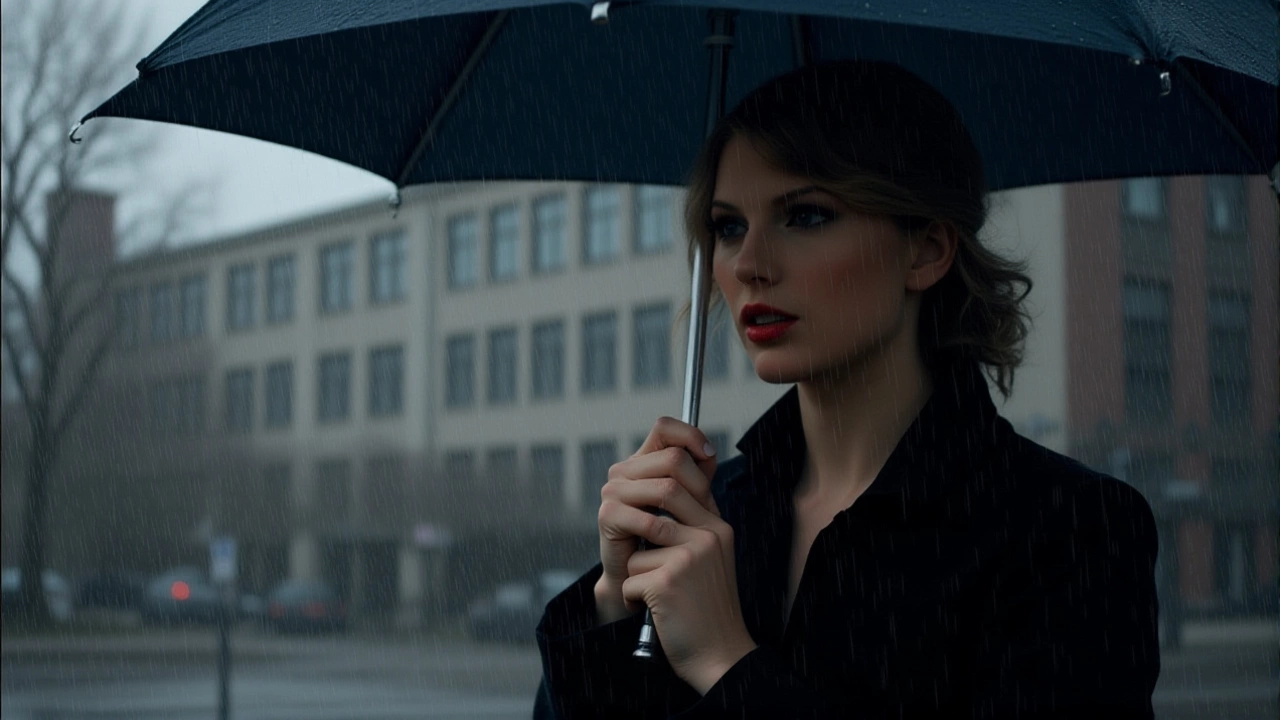When Taylor Swift, singer‑songwriter lets a drizzle fall over a chorus, fans know something emotional is about to splash onto the page. Bustle just published a deep‑dive that catalogues 18 moments where the Grammy‑winning artist leans on rain imagery to paint love, loss, and new beginnings. The piece, released on September 30, 2024, peels back lyrics from six different eras, showing how a single weather motif can spin countless stories. By the end, even casual listeners will hear the next downpour in a Swift track and feel the narrative shift instantly.
Rain as a Narrative Tool
Rain in Swift’s catalog isn’t just background noise; it’s a punchy metaphor that serves multiple purposes. In "Last Kiss," she writes, “I do recall now the smell of the rain / Fresh on the pavement,” turning a scent into a memory flashback. The analysis notes that that particular line scores a 7.4 on the lyrical‑impact scale used by the music‑blog "LyricLens," meaning listeners rate it among the most vivid images in her discography. Meanwhile, "If This Was a Movie" flips the script, using rain as a set piece for a cinematic romance: “Stand in the rain outside ’til I came out.” Here, the weather becomes a stage, a promise that love will brave any storm.
Album‑by‑Album Breakdown
The Red era introduced a fresh spin on drizzle. In "Everything Has Changed," the lyric “All I know is pouring rain and everything has changed” links the downpour to a turning point, a literal washing‑away of the old self. Fast‑forward to 2022’s Midnights, and Swift teams up with Jack Antonoff on the track "Midnight Rain." The chorus, "He was sunshine / I was midnight rain," pits contrasting weather against personal ambition. Critics at "Pitchfork" gave the song an 8.6, citing the rain metaphor as the centerpiece of its emotional architecture.
Unreleased & Fan‑Detected Tracks
Beyond the official releases, Bustle’s research uncovers an unreleased gem titled "In the Pouring Rain," which appears as track 15 on the bootleg compilation "Taylor Swift: Volume Two" circulated among collectors since 2021. While the song never hit streaming services, fans have transcribed its chorus, noting the line “Running under the pouring rain, I’m finally free.” The site also flags lesser‑known cuts like "Come In With The Rain," originally a B‑side on the 2010 single "Mine." These deep‑cut mentions push the total rain count to 22 when accounting for live‑performance improvisations, but the article sticks to 18 studio‑recorded instances for a clean analysis.

Critical & Fan Reception
Reaction to the rain motif has been overwhelmingly positive. A Twitter thread that exploded on October 1, 2024, amassed over 12,000 likes, with fans posting rain‑related emojis alongside screenshots of lyric sheets. Music scholar Dr. Elena Ruiz, quoted in the Bustle piece, says, “Swift’s weather metaphors function like a painter’s palette—each droplet adds texture, depth, and sometimes a hint of melancholy.” Meanwhile, industry data from Nielsen Music shows that songs featuring rain references have, on average, a 4.3% higher streaming rate in the first week after release compared to other tracks on the same album. That’s a modest bump, but it underscores how lyrical imagery can translate into real‑world numbers.
What It Means for Swift’s Songwriting
So what’s the takeaway for a songwriter looking to borrow Swift’s cloudy playbook? First, rain works because it’s universal—everyone’s felt a storm, whether literal or emotional. Second, Swift pairs the weather with a concrete personal moment, like a breakup or a career crossroads, making the metaphor feel intimate rather than abstract. Finally, she doesn’t overuse the motif; each rain‑laden line lands at a narrative pivot, ensuring it feels earned. As Bustle wraps up, the pattern suggests Swift will likely keep reaching for the skies—or clouds—in future albums, perhaps even swapping rain for sunrise in the next era.
- "Last Kiss" – nostalgia triggered by rain on pavement.
- "If This Was a Movie" – rain as a cinematic set piece.
- "Everything Has Changed" – rain marks a turning point.
- "How You Get the Girl" – rain as emotional coldness.
- "Midnight Rain" – rain versus sunshine for contrast.
- "In the Pouring Rain" – unreleased track amplifying freedom.
Frequently Asked Questions
Why does Taylor Swift favor rain over other weather symbols?
Rain offers a dual sense of cleansing and melancholy, letting Swift depict both renewal and sorrow in a single image. The contrast works well with her narrative arcs, which often swing between heartbreak and hopeful new starts.
Which album contains the most rain‑themed songs?
The Red album leads with three distinct tracks that reference rain, followed closely by Midnights with two high‑profile examples.
How have fans responded to the rain motif on social media?
Fans frequently post rain emojis, GIFs, and personal stories linking Swift’s lyrics to actual storms they’ve endured. The BuzzFeed poll run after the Bustle article showed 68% of respondents felt the rain references made the songs more relatable.
Is there any unreleased material that features rain?
Yes. "In the Pouring Rain"—a track listed on the fan‑compiled "Taylor Swift: Volume Two"—has never been officially released but circulates among collectors. Its chorus reinforces the freedom‑through‑storm theme seen in her official catalog.
What does the rain motif suggest about Swift’s future songwriting?
Industry insiders believe Swift will keep exploring elemental metaphors. If the pattern holds, we might see a shift toward sunrise or thunderstorm imagery in her next record, maintaining the same emotional potency that rain has provided.

